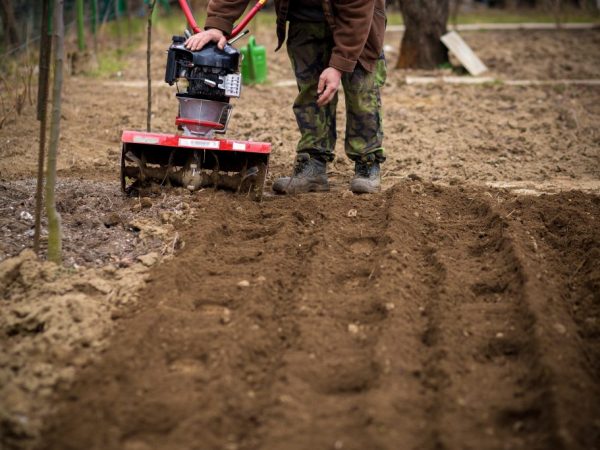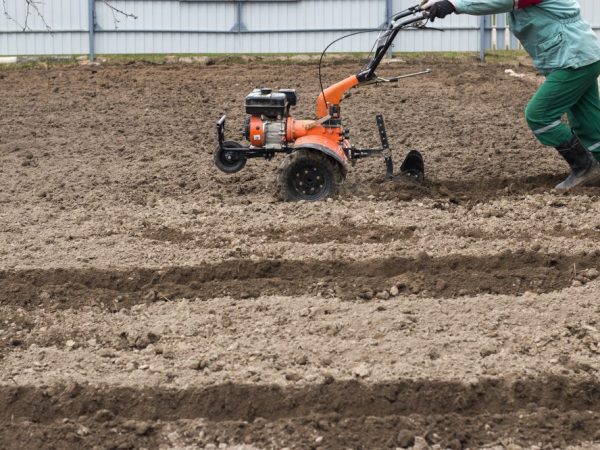Motoblock Neva for growing potatoes
Potatoes are one of the most popular crops. They are engaged in disembarking both for sale and for personal needs. Motoblock Neva for potatoes is an effective device that facilitates planting, care and harvesting.

Motoblock Neva for growing potatoes
Benefits of working with the Neva
Working with the Neva walk-behind tractor has a number of advantages:
- Reduced time spent. The walk-behind tractor speeds up the process several times compared to manual planting of potatoes.
- Reducing the need for human strength. To operate the walk-behind tractor, you need 1 person directing the machine. In the absence of an automatic potato planter, 1 more lays the seedlings in the ground.
- Profitability. Motoblock Neva consumes less fuel than heavy agricultural machinery.
- Versatility. A motor-cultivator is used to perform all work in the garden.
- Easy to use and maintain.
Description of the Neva walk-behind tractor
Technical characteristics of the Neva walk-behind tractor:
- dimensions - 1700 x 650 x 1300;
- track width - 320 mm (extended - 500 mm);
- ground clearance - 150 mm;
- turning radius - 800-1000 mm;
- weight - 87 kg;
- working speed - 8 km / h;
- cutter radius - 180 mm;
- maximum processing depth - 20 cm;
- maximum capture width - 1.2 m;
- fuel tank volume - 3.6 l;
- consumption during operation - 1 l / h.
Engine characteristics
When planting potatoes with a walk-behind tractor, the engine performance is an important factor. When working the soil, the machine must withstand a lot of resistance.
Motoblock Neva is equipped with a DM-1 4-stroke engine. Motor power - 6 HP The ball bearing in the struts ensures smooth and smooth operation. The liner is made of cast iron, which increases its service life.
The overhead valve arrangement ensures low fuel consumption and low operating noise. The air filter with double cleaning element guarantees trouble-free operation.
Using the Neva for growing potatoes

The walk-behind tractor performs several functions
Growing potatoes with Motoblock Neva includes the following operations:
- plowing;
- harrowing;
- landing;
- hilling;
- weeding;
- fertilization;
- digging the harvest.
The first step is preparing the soil for growing potatoes. Plowing allows you to loosen the top ball of soil, which saturates it with oxygen and moisture. Also, at an early stage of development, it is possible to get rid of weeds. For plowing, a working body in the form of a plow or a disc cutter is added to the walk-behind tractor.
For correct holding, adjust the grip and angle of attack. This allows the technique to move smoothly and to work the soil efficiently. The plowing depth for potatoes is 18-20 cm.
The next stage is harrowing. Its purpose is to allow the potato tubers to emerge unhindered. The walk-behind tractor is equipped with a special harrow.
Planting potatoes
To plant potatoes on the Neva walk-behind tractor, the following working bodies are installed:
- plow;
- hiller;
- potato planter.
When using a hiller and a plow, the implement only cuts the furrow. The potatoes are laid separately.
The advantage is speed and simplicity of construction. If the rows turned out to be nervous or not deep enough, there is an opportunity to go back and cut them again.
To automate the process, the walk-behind tractor is equipped with a potato planter. It can be hinged and in the form of a trailer. The device is equipped with a plow that cuts a furrow and a mechanism that simultaneously puts potatoes into the ground. It is possible to adjust the speed and step.
The disadvantage is the higher cost and higher fuel consumption for working with the unit. Also, the seed must be perfectly calibrated, otherwise there is a risk of damage.
Potato care
The Neva is used for hilling, weed removal and fertilization. They begin to spud when the first shoots appear. For this, a hiller is installed. There are both single and double working bodies, which accelerate inter-row processing.
Fertilizers are applied during hilling, equipping the equipment with a special nozzle. Also, when planting, minerals are added if the potato planter is equipped with a special device.
Harvesting
Before starting digging for processing rows, a topper is installed on the walk-behind tractor. He cuts bushes. For harvesting tops from the garden, a technique with a special rake is also used.
Digging potatoes is possible with a simple plow. A fan potato digger is more effective, allowing you to dig out a vegetable without damage. The sharp part of the organ cuts the soil under the roots, and the fruits cling to the arrows that pull them out. The advantage of the organ is the ability to dig on all types of soil.
An analogue is the vibrating potato digger KKM-1. The principle of its operation is a vibrating body. The plowshares cut the soil and the potatoes fall onto the vibrating grate. When shaken, the soil is removed through the holes, only the fruits remain. The disadvantage of this method is the complexity of the design and the possibility of damage to the dug out potatoes when vibrating.
The conveyor mechanism allows you to dig potatoes according to a similar principle. The difference is soil removal with a conveyor, not vibration. The disadvantage of the mechanism is poor performance on heavy soil. Digging in this way is more gentle to the fruit.
Conclusion
When planting and caring for potatoes with a Neva walk-behind tractor, you should adhere to all the rules for caring for the crop. Planting in highly moist soil requires the formation of ridges.
Weeding is carried out regularly: young weeds are easier to remove. If you do not carry out inter-row cultivation, pests attack the potatoes.


